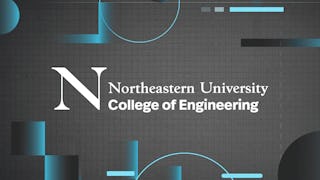Dive into the world of algorithm design, a fundamental aspect of computer science. This course provides a comprehensive understanding of various algorithmic design paradigms such as divide and conquer, greedy methods, dynamic programming, backtracking, and branch and bound. You will explore fundamental graph algorithms, gain practical experience in solving complex graph-related problems, and delve into randomized algorithms and complexity classes.



Algorithm Design: Mastering Computational Problem Solving

Instructor: BITS Pilani Instructors Group
Included with
What you'll learn
Master divide and conquer techniques to solve complex problems and enhance algorithm efficiency in software development.
Apply dynamic programming for decision optimization, storing and reusing sub-problems to improve computational problem-solving.
Design and analyze graph algorithms, including shortest paths and minimum spanning trees, to address network challenges.
Utilize branch and bound methods for solving optimization problems like 0-1 knapsack and traveling salesman with precision.
Skills you'll gain
Details to know

Add to your LinkedIn profile
August 2025
107 assignments
See how employees at top companies are mastering in-demand skills

There are 9 modules in this course
Explore the basic framework needed for representing and analyzing algorithms. The module provides a comprehensive understanding of asymptotic notations and a brief discussion of how recursive algorithms are analyzed.
What's included
16 videos10 readings14 assignments
Explore techniques for breaking down complex problems into manageable subproblems, with applications in sorting, searching, and mathematical computations.
What's included
13 videos4 readings14 assignments
In this module, you will gain insights into the algorithm design technique called the greedy method, which is a technique applicable to optimization problems, and how the method makes a series of greedy choices to construct an optimal solution (or close to optimal solution) for a given problem. You will also learn about greedy algorithms like fractional knapsack, activity selection problem, and job sequencing with deadlines.
What's included
9 videos4 readings9 assignments
In this module, you will gain insight into dynamic programming, which is a powerful problem-solving technique used in computer science to solve optimization and decision problems. You will also be introduced to the principles, algorithms, and applications of dynamic programming and learn how to break down complex problems into smaller sub-problems, store and reuse solutions to these sub-problems, and ultimately design efficient algorithms for various real-world challenges.
What's included
8 videos3 readings9 assignments
In this module, you will explore the graph concepts, different types of graphs, and how we can represent a graph in a computer. You will also gain insight into how to model problems as graphs and design efficient algorithms for a wide range of graph-related challenges like minimum spanning trees, single source shortest paths, all pair shortest paths.
What's included
8 videos3 readings8 assignments1 discussion prompt
In this module, you will explore a wide range of graph-related problems like finding the minimum spanning trees, single source shortest paths, and all pair shortest paths.
What's included
8 videos3 readings9 assignments
In this module, you will learn the concept of backtracking and its applications in problem-solving. Backtracking is a systematic algorithmic approach used to find solutions to problems where you need to make a sequence of decisions and if a decision leads to an unsatisfactory outcome, you backtrack to the previous decision and try an alternative path. This module covers the fundamentals of state space and explores specific problems such as the N-queen problem (4-queen problem), graph coloring problem, sum of subsets, and Hamilton cycle. You will also learn how to apply backtracking to find solutions to these problems.
What's included
33 videos9 readings31 assignments1 discussion prompt
In this module, you will learn the principles and applications of randomized algorithms. Randomized algorithms use randomization as a fundamental tool to solve computational problems efficiently and often provide probabilistic guarantees of correctness. This module explores several key randomized algorithms, including randomized quicksort, min-cut algorithm, random permutation, convex hull, and Bloom filters. You will also learn how to analyze the expected performance and probabilistic guarantees of these algorithms in various problem-solving scenarios.
What's included
10 videos2 readings8 assignments1 discussion prompt
In this module, you will gain a foundational understanding of P, NP, NP-complete, and NP-hard problems, as well as key concepts like satisfiability problem (SAT), polynomial time reducibility, and common NP-complete problems.
What's included
12 videos1 reading5 assignments
Instructor

Explore more from Algorithms
 Status: Preview
Status: PreviewClemson University
 Status: Preview
Status: Preview Status: Preview
Status: PreviewNortheastern University
Why people choose Coursera for their career





Open new doors with Coursera Plus
Unlimited access to 10,000+ world-class courses, hands-on projects, and job-ready certificate programs - all included in your subscription
Advance your career with an online degree
Earn a degree from world-class universities - 100% online
Join over 3,400 global companies that choose Coursera for Business
Upskill your employees to excel in the digital economy
Frequently asked questions
To access the course materials, assignments and to earn a Certificate, you will need to purchase the Certificate experience when you enroll in a course. You can try a Free Trial instead, or apply for Financial Aid. The course may offer 'Full Course, No Certificate' instead. This option lets you see all course materials, submit required assessments, and get a final grade. This also means that you will not be able to purchase a Certificate experience.
When you purchase a Certificate you get access to all course materials, including graded assignments. Upon completing the course, your electronic Certificate will be added to your Accomplishments page - from there, you can print your Certificate or add it to your LinkedIn profile.
Yes. In select learning programs, you can apply for financial aid or a scholarship if you can’t afford the enrollment fee. If fin aid or scholarship is available for your learning program selection, you’ll find a link to apply on the description page.
More questions
Financial aid available,


